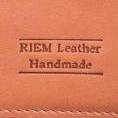-
Posts
143 -
Joined
-
Last visited
About zaynexpetty
- Birthday 05/17/1988
Profile Information
-
Gender
Male
-
Location
Utah.
-
Interests
Leathercrafting, rockhounding, camping, photography, and hiking.
LW Info
-
Leatherwork Specialty
Accessories
-
Interested in learning about
General Leathercrafting.
Recent Profile Visitors
5,468 profile views
zaynexpetty's Achievements

Member (2/4)
-

Last making without wood?
zaynexpetty replied to zaynexpetty's topic in Shoes, Boots, Sandals and Moccassins
Man, I was so focused on making something myself I didn't even think about modifying an existing last. Thanks guys! -
Hello all, First off, Ill start by pointing out that I am not a shoe/boot maker and have never made a pair. I have absolutely no experience in this field although I have been leather crafting accessories for a few years. That said; I'd like to take a stab at making a rough pair of boots. I'm not really interested in learning how to carve a pair of lasts out of wood at this point as it seems that this is an art of its own. Rather, I'd like a more simple way of making a pair of lasts. I've done a bit of reading about using a pair of old boots/shoes to pour some sort of resin/foam into to get a rough last shape out of, then shaping it. The problem is, the only information I've found about a substance which can be nailed into without cracking is this smooth-on foam #25. Which apparently is dense and rigid enough to put a nail into, but flexible enough to avoid cracking, according to a user in another thread. This foam used in combination with a thin layer of bondo apparently will do the job for a couple of pairs of boots/shoes. Problem is, this foam is $185 a gallon. This is completely unreasonable for me as I'm just doing this as a hobby. I also wonder if this foam would be rigid enough to stretch the leather over without altering the shape of the "last". Is there some other resin or plastic combo or otherwise I could use to achieve a "nail-able" and rigid material? Could I just melt some recyclable HDPE? Or would that deform the shoe I plan on using to pour the substance into? I need something that won't hurt my wallet, and is hard enough that I can form leather with it, but not so rigid that it would crack when nailed into. I really hope someone has some experience with this! Thanks again, Zayne
-
Hello all, First off, Ill start by pointing out that I am not a shoe/boot maker and have never made a pair. I have absolutely no experience in this field although I have been leather crafting accessories for a few years. That said; I'd like to take a stab at making a rough pair of boots. I'm not really interested in learning how to carve a pair of lasts out of wood at this point as it seems that this is an art of its own. Rather, I'd like a more simple way of making a pair of lasts. I've done a bit of reading about using a pair of old boots/shoes to pour some sort of resin/foam into to get a rough last shape out of, then shaping it. The problem is, the only information I've found about a substance which can be nailed into without cracking is this smooth-on foam #25. Which apparently is dense and rigid enough to put a nail into, but flexible enough to avoid cracking, according to a user in another thread. This foam used in combination with a thin layer of bondo apparently will do the job for a couple of pairs of boots/shoes. Problem is, this foam is $185 a gallon. This is completely unreasonable for me as I'm just doing this as a hobby. I also wonder if this foam would be rigid enough to stretch the leather over without altering the shape of the "last". Is there some other resin or plastic combo or otherwise I could use to achieve a "nail-able" and rigid material? Could I just melt some recyclable HDPE? Or would that deform the shoe I plan on using to pour the substance into? I need something that won't hurt my wallet, and is hard enough that I can form leather with it, but not so rigid that it would crack when nailed into. I really hope someone has some experience with this! Thanks again, Zayne
-

How do I clean suede?! - a hurricane Harvey casualty
zaynexpetty replied to geargarcon's topic in How Do I Do That?
White Vinegar is a safe way of killing mold. Use it after using the a brush to remove most of the residue, Id recommend the fiebings set with the soap. Afterward, spot treat the moldy areas with white vinegar, dab and then rub gently, wait for it to dry, then brush the areas with the suede brush. Vinegar is also effective at removing odors. If you still have a slight vinegar smell afterwards I think just using a dusting of baking soda should help neutralize it. Not sure if it would have any ill effects on the suede. I'd test it out on a scrap piece if you have one. -

How do I clean suede?! - a hurricane Harvey casualty
zaynexpetty replied to geargarcon's topic in How Do I Do That?
Fiebings makes a brush and bar combo that helps clean suede and nubuck without the use of liquid. -
Hello all, I'm making my second batch of vinegaroon and I can't remember if I used Apple Cider Vinegar or White Vinegar the first time around. I also don't remember what size of bottle I got, and the ratio of wool to vinegar. I bought a gallon of apple cider vinegar. Will this work? Would white vinegar work better? How many pads of steel wool for 1 gallon? Thanks again, Zayne
-
Is tokonole as wet as gum trag? or is it more of a paste?
-
oh, yes. I know 4/5 oz is not very thin haha. Its just the thinnest leather I work with. Im finding that with natural, un-dyed leather, it is best to lightly and VERY carefully wet the edge, wait until it has dried up some a little, burnish it with a rotary burnisher, apply slightly soft beeswax to the edge carefully, burnish again with rotary burnisher. I'm still having an issue with the edge rolling over a little bit on the flesh side, but its not that big of a deal. Sometimes I bevel the inside edge again after burnishing if its curled over too much. I generally don't have a problem with dyed leather (other than applying beeswax in cold weather). My process for burnishing dyed leather goes as such: sand edge with medium grit (sometimes i will use a higher grit if i feel its too fuzzy on the edge, but i generally use grade A hermann oak with doesn't really have that problem so much wet edge with mixture of 50/50 water and liquid saddle soap VERY carefully with wool dauber wait until edge has dried up a little burnish with rotary burnisher (i have the hole master tip - drill burnisher from pro edge burnishers) rub on beeswax carefully and thoroughly burnish again with rotary burnisher rub edge vigorously with scrap canvas piece to smooth over and get rid of the white residue from the beeswax sometimes i will reapply beeswax a second time if i feel i didn't get good coverage.
-
Hello, I posted a similar topic a few years ago and I'm hoping to re-ignite the subject. I've been trying different methods over the years and I still have not found a clear-cut (or even close) method of burnishing thinner (i'm using 4/5 oz) natural leather without the edges being darkened too much and without making a mess of the face of the piece (or the flesh side, for that matter). I really like the look of completely untouched natural leather, so I don't want to put any sort of conditioner/sheen on the face as they all darken the leather at least a shade. I want to keep the natural leather as white/pink as possible with minimal water/paste mess from burnishing. I'm also having somewhat of an issue with the flesh edge of the leather folding over some with the thinner leather. I might be burnishing too quickly after wetting the edge, I don't know. I am using a pro edge burnisher in my drill press which works very well. Methods I've tried: - Just water This solves the edge darkening problem and also solves the mess problem when applied extremely carefully with a dauber or your finger. However, it doesn't give a lasting extra slick finish. - Just liquid Saddle soap This gives a slick finish, but darkens the leather edge a lot and also seems to soak into the leather more, which means messy and uneven looking edges. - 50/50 liquid Saddle soap and water This darkens the edge a bit less (still more than i'd like) and soaks in a bit less, but isn't as slick as just straight up liquid saddle soap. - 50/50 liquid Saddle soap and water, then beeswax, then canvas burnishing. Creates a slick edge, but is very hard to keep clean, and darkens the edge quite a bit. - Gum Tragacanth Creates a good slick edge (one coat is good, two coats is better), but is really really hard to keep clean. Doesn't darken the edge as much as the straight liquid saddle soap, but still darker than I like. One thing I did discover recently is that applying gum trag to the edge with the edge of a toothpick works well for keeping it clean, but is very tedious. Should I maybe burnish the edge with just water first before burnishing with gum trag? would that help keep the trag from seeping onto the face? I guess I'm just hoping that some magician out there has come up with a magical method/product that is easy to apply/won't make a mess/won't darken the edge too much. Haha. I'm also having a hard time with applying beeswax as its hardness makes it difficult to apply a sufficient amount of wax to the edge. I was considering making a mixture of beeswax, olive oil, and eucalyptus oil to stave off mould. I've heard of a beeswax/neatsfoot solution, but would prefer to use olive oil in its place. Does anyone have any experience with a wax/olive oil blend? I prefer not to use any paraffin. Thanks again, Zayne
-
I've been ordering through buckle guy for a couple years, great company, and I love that they don't have minimums. Just looking for similar style/quality with a wider variety. Sounds like I'm going to have to save up and order wholesale. In that case, what are some good wholesale suppliers that have similar quality/style?
-
I am a huge fan of buckle guy, but I am looking for some more suppliers that offer similar quality/style without minimums. I am specifically looking for some sleek/minimal looking solid brass center bar buckles. It would also need to be a situation where I could continue to buy stock in the future, so I don't think anything on eBay or amazon would be a good choice (unless you know more than I do). Ive checked out buckleguy, OTB, leatherguy, leathersmith, weaver, zack white, tandy, springfield, brettuns... Maybe overseas? I don't know. Thanks! Zayne
-
I didn't take top side photos because my concern wasn't about the top side. Also, I stated that I liked the top side of the swatch they sent me, so that is kind of irrelevant. Yes, I realize it was not a fair comparison (as the other two commenters already pointed out), because the swatch they sent me was most likely not split, whereas the Hermann Oak piece was.
-
Ahhh, okay. I still have a lot to learn about the different cuts and their attributes. I pretty much have just been ordering the highest quality sides in whatever oz I need and hope for the best.
-
I do a lot of accessories like belts and wallets, so I like the flesh side to be as tidy as possible without much work (or any preferably). Thank you for the knowledge! I guess I didn't take into consideration that the swatches were most likely not split. Great point. I did get a response from the sales manager stating that the tooling swatch I received (i sent him a picture) might have been cut from the belly, but wouldn't it be a lot thinner (not 8-10 oz) if it was?
-
Well, thats good news! I don't think it was split, because it seems to be some of their "8-10 oz" which they then will split down for you. The HO piece I have there is 4/5 oz so I'm assuming it was split, but it was just in my scraps and it might have been from a less than A grade quality part of the side I purchased. Still, I liked it better than the swatch WC sent.




